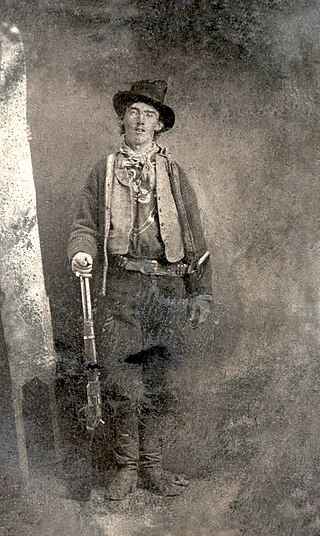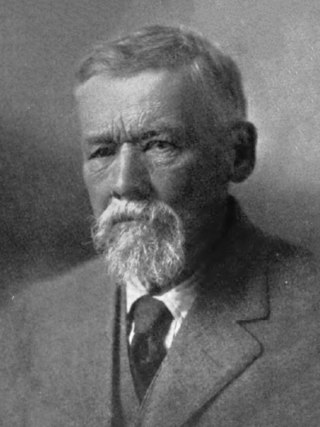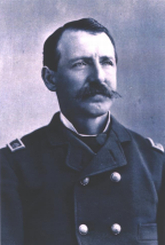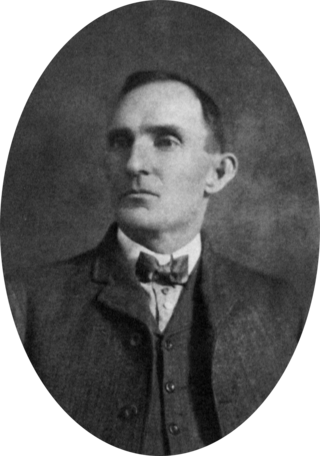Related Research Articles

Tularosa is a village in Otero County, New Mexico, United States. It shares its name with the Tularosa Basin, in which the town is located. To the east, Tularosa is flanked by the western edge of the Sacramento Mountains. The population was 2,553 at the 2020 census. During the 1990s and early 2000s, the town, north of the much larger Alamogordo, experienced moderate growth and construction as a bedroom community, especially in the housing industry. Tularosa is noted for its abundance of cottonwood shade trees and its efforts to preserve the adobe-style architecture of its past.

The Lincoln County War was an Old West conflict between rival factions which began in 1878 in Lincoln County, New Mexico Territory, the predecessor of the state of New Mexico, and continued until 1881. The feud became famous because of the participation of William H. Bonney. Other notable participants included Sheriff William J. Brady, cattle rancher John Chisum, lawyer and businessmen Alexander McSween, James Dolan and Lawrence Murphy.

Albert Bacon Fall was a United States senator from New Mexico and Secretary of the Interior under President Warren G. Harding who became infamous for his involvement in the Teapot Dome scandal; he was the only person convicted as a result of the affair. As a captain in the United States Army, he supported a military invasion of Mexico in 1916 as a means of ending Pancho Villa's raids.

Patrick Floyd Jarvis Garrett was an American Old West lawman, bartender and customs agent known for killing Billy the Kid. He was the sheriff of Lincoln County, New Mexico, as well as Doña Ana County, New Mexico.

John Horton Slaughter, also known as Texas John Slaughter, was an American lawman, cowboy, poker player and rancher in the Southwestern United States during the late 19th and early 20th centuries. After serving in the Confederate States Army during the American Civil War, Slaughter earned a reputation fighting hostile Indians and Mexican and American outlaws in the Arizona and New Mexico territories. In the latter half of his life, he lived at the San Bernardino Ranch, which is today a well-preserved National Historic Landmark in Cochise County in far southeastern Arizona. In 1964, he was inducted into the Hall of Great Westerners of the National Cowboy & Western Heritage Museum.

Colonel Albert Jennings Fountain was an American attorney who served in the Texas Senate and the New Mexico House of Representatives. Following a purge of corruption among cattle rustlers that Fountain investigated and prosecuted, he and his eight-year-old son Henry disappeared near White Sands, New Mexico Territory. Their bloodstained wagon and other evidence of an ambush were recovered, but the bodies were never found. Suspicion centered on two rival landowners, Oliver M. Lee and Albert Bacon Fall. Lee and two employees were tried for the murder of Henry Fountain, but acquitted after a defense by Fall. No charges were ever filed for the death of Albert Fountain.

James Brown Miller, also known as "Killin' Jim", "Killer Miller" and "Deacon Jim", was an American outlaw and title-holder gunfighter of the American Old West, said to have killed 12 people during gunfights. Miller was referred to by some by the alias "Deacon Jim" because he regularly attended the Methodist Church, and he did not smoke or drink. He was lynched in Ada, Oklahoma, in 1909 along with three other men, by a mob of residents angry that he had assassinated a former deputy U.S. marshal.

The Tularosa Basin is a graben basin in the Basin and Range Province and within the Chihuahuan Desert, east of the Rio Grande in southern New Mexico and West Texas, in the Southwestern United States.
John M. Larn was a western American lawman and later outlaw who, with gunfighter John Selman, operated a cattle rustling ring in Shackelford County, Texas, for over a year.

Commodore Perry Owens was an American lawman and gunfighter of the Old West. One of his many exploits was the Owens-Blevins Shootout in Arizona Territory during the Pleasant Valley War.
Jesse Wayne Brazel, or Wayne Brazel, was an American Old West ranch hand, during the closing years of that era. Brazel's place in history resulted from his 1908 confession and trial for the fatal shooting of former lawman Pat Garrett who, more than a quarter of a century earlier in 1881, had tracked down and killed Henry McCarty, also known as Billy the Kid.
The San Elizario Salt War, also known as the Salinero Revolt or the El Paso Salt War, was an extended and complex range war of the mid-19th century that revolved around the ownership and control of immense salt lakes at the base of the Guadalupe Mountains in West Texas. What began in 1866 as a political and legal struggle among Anglo Texan politicians and capitalists gave rise in 1877 to an armed struggle by ethnic Mexican and Tejano inhabitants living on both sides of the Rio Grande near El Paso against a leading politician, who was supported by the Texas Rangers. The struggle reached its climax with the siege and surrender of 20 Texas Rangers to a popular army of perhaps 500 men in the town of San Elizario, Texas. The arrival of the African-American 9th Cavalry and a sheriff's posse of New Mexico mercenaries caused hundreds of Tejanos to flee to Mexico, some in permanent exile. The right of individuals to own the salt lakes, which had previously been held as a community asset, was established by force of arms.

Oliver Lee Memorial State Park is a state park of New Mexico, United States, whose two tracts preserve a canyon in the Sacramento Mountains and Oliver Lee's historic 19th-century ranch house. The 640-acre (260 ha) park is located in Otero County at an elevation of 4,363 feet (1,330 m). It is situated at the base of Dog Canyon and provides opportunities for camping, hiking, picnicking, wildlife viewing, a nature trail, and guided tours of the ranch house.
David Lawrence Anderson was a 19th-century American outlaw, better known under the alias Billy Wilson, who rode with Billy the Kid following the Lincoln County War. In his later years, he also served as a law enforcement officer and a U.S. customs inspector.
George W. Hindman was a 19th-century American cowboy and law enforcement officer serving as a deputy sheriff of Lincoln County, New Mexico, during the early months of the Lincoln County War.
The Battle of Lincoln, New Mexico, was a five-day-long firefight between the Murphy-Dolan Faction and the Regulators that took place between July 15–19, 1878, in Lincoln, New Mexico. It was the largest armed battle of the Lincoln County War in the New Mexico Territory. The firefight was interrupted and suppressed by United States Cavalry led by Lt. Col. Nathan Dudley from Fort Stanton.
Harvey H. Whitehill was a sheriff of the American Old West, whose life as a lawman was documented in the book Sheriff Harvey Whitehill; Silver City Stalwart, by author Robert Alexander. Alexander also wrote extensively about Whitehill in Six-Guns and Single-Jacks: A History of Silver City and Southwestern New Mexico.

Frank Wilson Parker was an American judge who served on the New Mexico Supreme Court for 35 years, from its territorial period to after statehood.

The Kid from Texas is a 1950 American Western film that was Audie Murphy's first Technicolor Western and the first feature film on Murphy's Universal-International Pictures contract. It was directed by Kurt Neumann and featured Gale Storm and Albert Dekker.

Among the Dust of Thieves is a 2013 American drama film about the 1896 disappearance of Albert Jennings Fountain, directed by Sean Pilcher. The film dramatizes the days leading up to Fountain’s disappearance near White Sands, New Mexico and the first, unsuccessful investigation of his apparent murder by John C. Fraser of the Pinkerton Agency. The film strongly suggests that Fountain’s disappearance was directly linked to his prosecution of Oliver M. Lee for cattle rustling. The narrative switches from Fountain’s investigation and arrest of Lee culminating in Fountain’s disappearance, to Fraser’s investigation, which concludes after a shootout at Lee’s ranch.
References
- ↑ McLemore, Virginia T. (February 1996). "Oliver Lee Memorial" (PDF). New Mexico State Park Series. New Mexico Geology. Archived from the original (PDF) on 13 July 2014.
- ↑ William "Billy" McNew - there were two men by the name of "William McNew" ranching in Otero County, New Mexico. William H. McNew was born circa 1859 in Arkansas or Missouri, and is most likely notBilly McNew. The second William McNew was born in Texas, circa 1866, and is most likely the Lee confederate.[ citation needed ]
- ↑ Adams, Ramon F.; Metz, Leon C. (October 1975). "Pat Garrett: The Story of a Western Lawman". The Western Historical Quarterly. 6 (4): 458. doi:10.2307/967800. ISSN 0043-3810. JSTOR 967800.